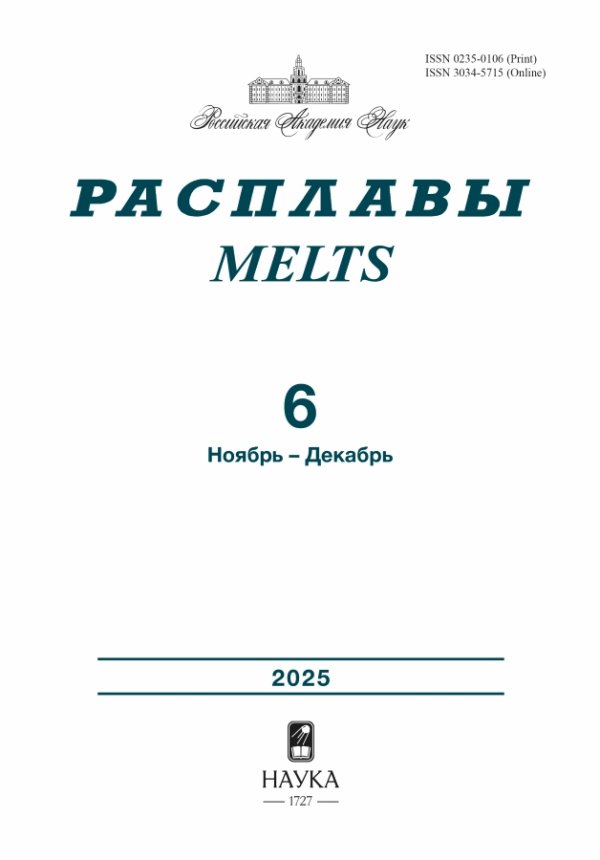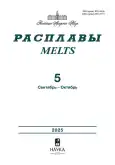Effect of Adsorption of Halogenide Ions on the Capacity of Iridium Electrode in Molten Salts
- Authors: Kirillova E.V.1
-
Affiliations:
- Institute of High-Temperature Electrochemistry UB RAS
- Issue: No 5 (2025)
- Pages: 421-429
- Section: Articles
- URL: https://bakhtiniada.ru/0235-0106/article/view/309546
- DOI: https://doi.org/10.31857/S0235010625050015
- ID: 309546
Cite item
Abstract
The adsorption activity of the iridium electrode in molten sodium, potassium and cesium chlorides and bromides, sodium and potassium iodides was estimated from the dependence of the shape and position of the capacitance curve on the cation-anion composition of the electrolyte, the AC frequency and temperature. The capacitance curves have a complex shape with two main minima and a maximum between them in the entire studied ranges of temperature, frequency and electric polarization. In some cases, one or two additional minimа appear on the curves between the main minima. The position of both the minima and maxima of the capacitance depends on the radius of the salt cation and anion. The dependence of the position of the main maximum of the capacitance on the radius of the cation and anion is presented at T=1093 K in the AC frequency range of 3·100–1·104Hz. According to this approach, the potential of the capacitance maximum of a solid metal electrode in ionic melts with specifically adsorbing anions can be considered as the critical potential of the adsorption phase transition. The segment of the capacitance curve ΔEfrom the cathodic capacitance minimum, which corresponds to the classical minimum capacitance, to the capacitance maximum can be considered as a range of potentials in which the change in the properties of the double electric layer obey the Gouy-Chapman-Stern model. With a further shift from the critical potential to the positive direction, the electrostatic adsorption mechanism turns into chemical adsorption, with the transfer of part of the anions from the salt phase to the electrode and the formation of complex compounds. The value ofΔEcan help to estimate the effect of specific adsorption of halide ions on the shape of the capacitance curve.
Keywords
About the authors
E. V. Kirillova
Institute of High-Temperature Electrochemistry UB RAS
Author for correspondence.
Email: e.kirillova@ihte.ru
Yekaterinburg, Russia
References
- Bukun N.G., Alekseeva R.A. Double layer capacitance of Au in chloride melts // Elektrokhimiya.1975. 11. P.239–249. [In Russian]
- Bukun N.G., Ukshe E.A. Electrostatic adsorption of ions and and the structure of the double electric layer in binary salt melts // Physical chemistry and electrochemistry of melts, salts and slags. Proc. 3 of the All-Union Conference, May, 1966. L.: Khimia. 1968. P. 214−223. [In Russian]
- Delimarsky Yu.K., Kikhno V.S. Determination of zero points of some solid metals in a molten NaCl−KCl mixture by measuring the double layer capacity // Ukrainian Chemical Journal. 1964. 30. P. 1156. [In Russian]
- Delimarsky Yu.K., Kikhno V.S. Zero points of metals in molten salts // Elektrokhimiya. 1969.5. № 2. P. 145−150. [In Russian].
- Frumkin A.N. Potentials of zero charge. М.: Nauka. 1979. 260 P. [In Russian]
- Nishi N., Hashimoto A., Minami E. and Sakka T. Electrocapillarity and zero-frequency differential capacitance at the interface between mercury and ionic liquids measured using the pendant drop method // Phys. Chem. Chem. Phys. 2015. 17. 5219.
- Pajkossy T., Kolb D.M. Anion-adsorption-related frequency-dependent double layer capacitance of the platinum-group metals in the double layer region // Electrochimica Acta. 2008.53. P. 7403–7409.
- Pajkossy T., Müller C., Jacob T. The metal–ionic liquid interface as characterized by impedance spectroscopy and in situ scanning tunneling microscopy // Phys. Chem. Chem. Phys. 2018. 20. P. 21241–21250.
- Alam M., Islam M., Okajima T., Ohsaka T. Capacitance Measurements in a Series of Room-Temperature Ionic Liquids at Glassy Carbon and Gold Electrode Interfaces // J. Phys. Chem. С. 2008.112. P. 16600–16608.
- Stepanov V.P. Physical chemistry of the surface of solid electrodes in salt melts. Ekaterinburg: UB RAS, 2005. 324 P. [In Russian]
- Dokashenko S.I., Stepanov V.P. Structure of the double electric layer on liquid metal electrodes in individual melts of alkali metal halides // Elektrokhimiya. 1993.29. 11. С. 1301−1305. [In Russian]
- Stepanov V.P., Dokashenko S.I., Kirillova E.V. Frequency dependence of potentials of minimum capacitance for electrodes of copper subgroup metals in alkali halide melts // Russ. J. Electrochem. 2012. 48. P. 1005–1010.
- Kirillova, E.V., Stepanov, V.P. A Potential-Induced Transformation in the Double Electrical Layer on the Rhenium Electrode in Alkali Chloride Melts // Materials. 2021. № 14(20). P. 6009.
- Kirillova E.V., Stepanov V. P. The оrdеr-disоrdеr phase transition in the adsorption layer at а gold electrode in molten alkali bromides // Current Topics in Electrochemistry. 2022. 249. P. 101–108.
- Kirillova E.V. Capacity and impedance of an iridium electrode in molten alkali metal chlorides // Rasplavy (Melts). 2023. 1. С. 68–77. [In Russian]
- Kirillova E.V. Capacitance and Impedance of an Iridium Electrode in Molten Alkaline Metal Bromides // Russian Metallurgy (Metally). 2024. № 4. P. 763–767.
- Iridium: compounds information // URL: https://www.webelements.com/iridium/compounds.html
- Magnussen O.M. Ordered Anion Adlayers on Metal Electrode Surfaces // Chem. Rev. 2002. 102. P. 679−725.
Supplementary files









